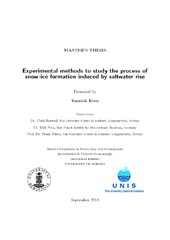| dc.contributor.author | Kern, Yannick Rouven | |
| dc.date.accessioned | 2018-11-13T16:33:46Z | |
| dc.date.available | 2018-11-13T16:33:46Z | |
| dc.date.issued | 2018-11-09 | |
| dc.date.submitted | 2018-11-08T23:00:02Z | |
| dc.identifier.uri | https://hdl.handle.net/1956/18717 | |
| dc.description.abstract | The Arctic region is experiencing a change from thick multiyear to much younger and thinner sea ice. In many places, increasing precipitation is leading to higher snow loads on young sea ice. Hence seawater can infiltrate the snow layer through pathways in the ice from below or from the side. Consequently parts of the snow layer may form a slushy layer that can freeze and form so called “snow ice”. Involved processes have substantial impacts on sea ice and snow in terms of salinity and temperature. The spatial and temporal evolution of these is still only poorly understood. In this context my study concentrates on the establishment of unique measurement methods to investigate thermodynamics, temperature evolution and salt rejection during snow-ice formation. For the investigation of saltwater rise in snow and subsequent freezing I adapt existing methods from sea-ice investigations to the application in snow. I developed two new cost-efficient experimental setups in the cold laboratory environment at the University Centre in Svalbard to first, investigate saltwater rise in snow and second, realistically represent floating ice and vertical flooding. The salinity harp installed in snow and sea ice provides a non-destructive method to measure the impedance and temperature at high temporal and spatial resolution. Within the scope of 14 experiments at different parameter setups I find salinity of the flooding water to be the predominant driver of water rise and freezing. Results suggest a transition with time and height from capillary rise to freezing and brine drainage in the initial 24 h after flooding if initial temperatures between flooding water and pre-existing snow differ. Furthermore, first results of vertical flooding of floating ice highlight the capability of the new experimental setup. Characteristics indicate that ocean water displaces brine in sea ice which is pushed to the ice-snow interface and wets the snow. The presented methods provide a promising foundation for further investigations of vertical rise of water through sea ice and subsequent snow-ice formation. | en_US |
| dc.language.iso | eng | eng |
| dc.publisher | The University of Bergen | en_US |
| dc.subject | saltwater rise | eng |
| dc.subject | water rise | eng |
| dc.subject | snow-ice formation | eng |
| dc.subject | snow ice | eng |
| dc.subject | Havis | nob |
| dc.subject | Arktis | nob |
| dc.subject | salinitet | nob |
| dc.title | Experimental methods to study the process of snow-ice formation induced by saltwater rise | en_US |
| dc.type | Master thesis | |
| dc.date.updated | 2018-11-08T23:00:02Z | |
| dc.rights.holder | Copyright the Author. All rights reserved | en_US |
| dc.description.degree | Master's Thesis in Meteorology and Oceanography | en_US |
| dc.description.localcode | MAMN-GEOF | |
| dc.description.localcode | GEOF399 | |
| dc.subject.realfagstermer | https://data.ub.uio.no/realfagstermer/c005668 | |
| dc.subject.realfagstermer | https://data.ub.uio.no/realfagstermer/c030972 | |
| dc.subject.realfagstermer | https://data.ub.uio.no/realfagstermer/c001464 | |
| dc.subject.nus | 756213 | eng |
| fs.subjectcode | GEOF399 | |
| fs.unitcode | 12-44-0 | |
